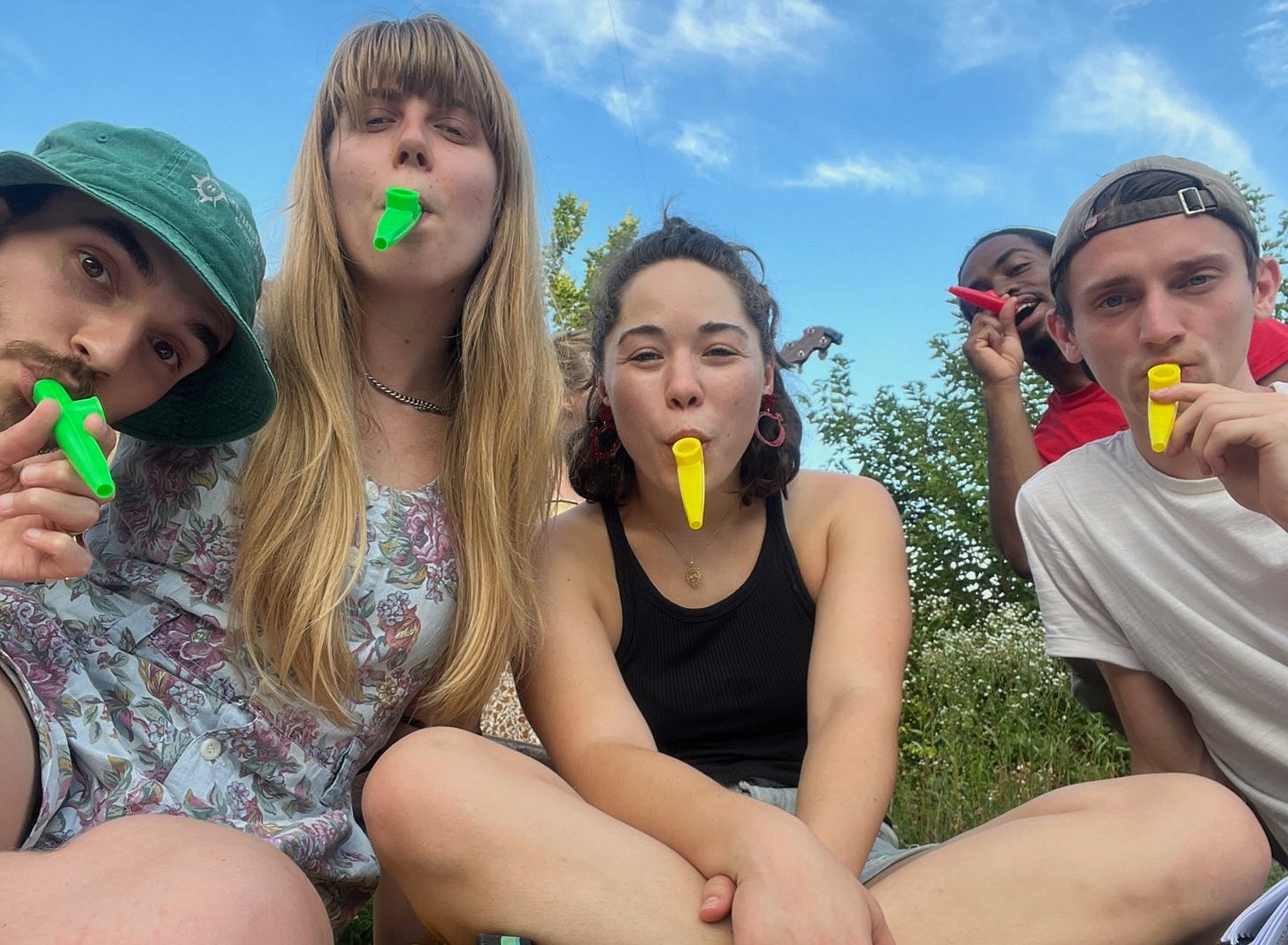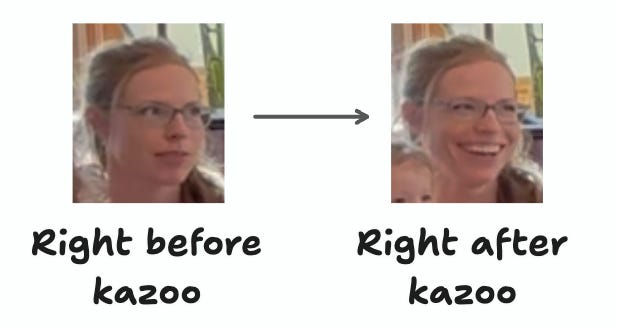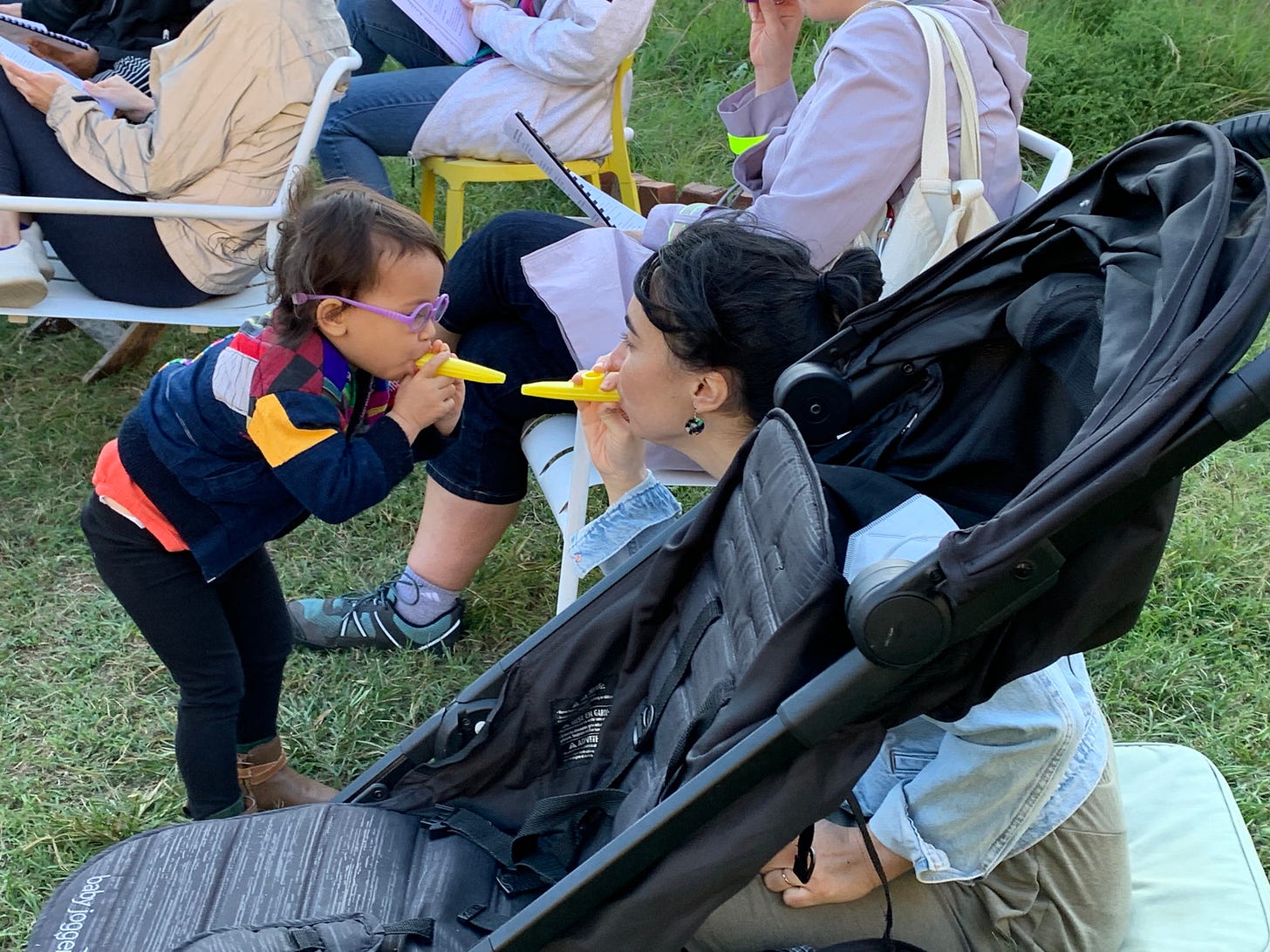Sing-along innovation: The surprisingly awesome kazoo
I'm a sing-along impresario in my spare time, and I recently made a breakthrough discovery in hootenanny technology: The surprisingly awesome kazoo.
Kazoos have added a musical and participatory richness to sing-alongs that I never expected — and that never fails to inspire delighted grins in the audience.
In this post, I want to share my kazoo discovery: I’ll explain how I incorporate kazoos, why they’re surprisingly awesome, and how I discovered their potential. Hopefully you’ll be inspired to try kazoos at your sing-alongs — or to try it out at a D.C. Sing-Along hootenanny!
How I use kazoos in sing-alongs
I’ve incorporated kazoos into a bunch of songs, as a stand-in for a variety of instruments:
Horn Parts
The horn riffs in Ring of Fire and Sweet Caroline.
Synthesizer Parts
The synth riffs in Take On Me, Mr. Brightside (post-chorus), and Dancing on My Own (ditto).
Guitar Parts
The guitar riffs/licks in Girls Just Want to Have Fun, Brown Eyed Girl, and Respect; the solos in The Middle and Say It Ain’t So.
Whistle Parts
The whistle solo in Me and Julio Down by the Schoolyard.
Flute Parts
The panpipe riff in My Heart Will Go On and flute solo in California Dreamin'.
Steel Drum Parts
The (faux) steel drum riff in Under the Sea.
Why kazoos are surprisingly awesome
Kazoos are musically legit
When I first had the idea, I assumed kazoos would be a goofy gimmick: We’d use them for a song or two, but kind of roll our eyes and probably want to cover our ears.
But it turns out kazoos actually sound good.
Yes, they’re goofy. But they sound much more like an instrument than a toy, with a rough, distorted sound that’s more rawk than Raffi.
Kazoos turn non-musicians into musicians
I center my hootenannies on the singers (of all skill levels) rather than the musicians, but I think singers sometimes still feel apart from the musicians. Kazoos bridge the gap, letting non-musicians feel like they're playing an instrument.
Kazoos are super accessible: They’re easy to “play” (if you can hum, you can kazoo) and non-intimidating (they look like toys). Plus they’re just fun!
Kazoos expand and enrich the repertoire
Kazoos are the first viable way to add memorable/crucial riffs and solos — like the Take on Me synth riff — to the sing-along repertoire and experience.
Countless songs include these elements, which typically wouldn’t work in the sing-along context. Either nobody can play the part on acoustic guitar, or if someone can play the part it’s either too quiet or becomes too much of a performance. So you end up playing a song like Take on Me without its crucial riff — which subtly diminishes what makes it so beloved — or omitting the song entirely, as I did before the kazoo discovery.
But with kazoos, those riffs and leads are newly viable — and in a way that matches my sing-along ethos of being about the group, not the musicians.
One caveat: I’ve found riffs and short parts to be more successful than longer parts and solos. More people can more easily pick up the short parts: I can teach short riffs, and many are embedded in our collective memory. Whereas the Me and Julio whistle part is too long to teach, so it’s often just me and a couple audience members tooting that one, which is less participatory than I prefer.
Kazoos Keep Kids Engaged
Kids love kazoos.
They love making funny noises. They love having something to interact with. If they’re old enough to realize it, they love the feeling of playing an instrument. And for self-conscious tweens and teens who don’t want to be seen loving anything, kazoos help them tap into being a goofy kid again. (Sorry, blasé friend: Even if you’re tooting with a stone face, I can tell you’re into it.)
Of course this one is a mixed bag: Especially younger kids can be … let’s say overzealous in their kazooing, which can create cacophony.
The kazoo innovation process
I discovered the kazoo’s potential while thinking about how to introduce more fun participation elements to my hootenannies.
I remembered a cool makeshift instrument from my college a cappella group: Becky Bascom used a comb with a piece of paper in front of it to create a vocal distortion effect while singing the California Dreamin’ flute solo and Sweet Child O’ Mine guitar solos. I thought I might be able to use a kazoo for the same effect.
I ordered a batch of kazoos on Amazon to test myself. As soon as I did my first at-home test, I knew I had discovered something revolutionary.
I quickly validated the awesomeness with my music buddy Lawrence, then did a beta test at a House Hootenanny™. I brought kazoos to the next public sing-along, and the rest is history. I’ve since led 15-plus hootenannies with kazoos including the Takoma Park Folk Festival and Petworth PorchFest, and they’re a huge hit every time.
Tips for Sing-Along Leaders
Which kazoos should you buy?
I use these kazoos from Amazon ($12 for 20). The “reeds” are consistently fastened and loud. (I tried a 50-pack from the same manufacturer, but it turned out to be a different model and had a ton of duds. So I only by the 20-pack to be safe.)
These come in individually wrapped pairs; at the beginning of a sing-along I put a wrapped pair on every other seat, so participants know they’re fresh. I tell people to take the kazoos home and bring them to the next hootenanny they attend.
I don’t like the environmental implications of using cheap plastic kazoos, but don’t have a good near-term alternative.
How to play kazoo and guitar at the same time
I’ve tried both clamping my kazoo in a harmonica holder and taping a kazoo to my microphone:
I’ve settled on the mic-taping approach, as it’s easier to quickly switch between kazoo and vocals. But I’m never sure how well the taped kazoo gets picked up by the mic — it’s not an issue in small rooms, but definitely can be a challenge for larger spaces or outdoor sing-alongs.







Kazoos: One small step for man (Josh, to introduce them), one giant leap for hootenanies everywhere.